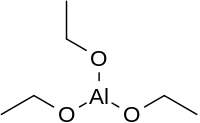Aluminium triethoxide
 | |
| Identifiers | |
|---|---|
| 555-75-9 | |
| ChemSpider | 21171290 |
| |
| Jmol-3D images | Image |
| PubChem | 16685041 |
| |
| Properties | |
| Molecular formula |
C6H15AlO3 |
| Molar mass | 162.16 g·mol−1 |
| Appearance | White powder |
| Density | 1.142 g/cm3 |
| Melting point | 140 °C (284 °F; 413 K) |
| Boiling point | 320 °C (608 °F; 593 K) |
| reacts violently | |
| Solubility | slightly soluble in xylene, chlorobenzene |
| Hazards | |
| Flash point | 210 °C (410 °F; 483 K) |
| Except where noted otherwise, data is given for materials in their standard state (at 25 °C (77 °F), 100 kPa) | |
| Infobox references | |
Aluminium triethoxide is a reducing agent that exists as a white powder under room temperature and standard atmospheric pressure. The chemical is mainly used in industrial settings and has played an important role in reducing the cost of the production of bimetallic aluminium catalysts.[1]
Properties
Aluminium triethoxide is hygroscopic, and decomposes into aluminium hydroxide and ethanol after it absorbs moisture from the air. Aluminium triethoxide is slightly soluble in hot dimethyl benzene, chlorobenzene and other high boiling point non-polar solvents.[2]
Applications
Aluminium triethoxide is used as a reducing agent for aldehydes and ketones, and is also used as a polymerization catalyst. Aluminium triethoxide is mainly used in the Sol-Gel Process preparation of high purity aluminium sesquioxide, which is a polymerization agent. At the same time, it is used as a reducing reagent, for example, carbonyl compounds that restore to alcohol.
Synthesis methods
Aluminium triethoxide is produced by the heating reaction of an aluminium amalgam with anhydrous alcohol. All the reagents go through a strict water treatment, and the instrument devices prevent humidity from entering.
Aluminium triethoxide is also produced by reacting aluminium with anhydrous alcohol, but this reaction needs the participation of iodine (I
2) and mercuric chloride (HgCl
2) as catalysts.
Notes
- ↑ Prof. Michael North; Dr. Carl Young (2 November 2011). "Reducing the Cost of Production of Bimetallic Aluminium Catalysts for the Synthesis of Cyclic Carbonates" (WEB PAGE (ABSTRACT)). Wiley Online Library. John Wiley & Sons, Inc. Retrieved 25 March 2012.
- ↑ The Merck Index, 15th Ed. (2013), p. 62, Monograph 334, O'Neil: The Royal Society of Chemistry. Available online at: http://www.rsc.org/Merck-Index/monograph/mono1500000334